66 Models
1954
Yashicaflex S
The 66 Models are in chronological release date order split over seven pages to assist with the speed of displaying images.
The background to 66 Models and the various notes are at the beginning of the first page, 1953-1954.
Models
(Scrolling will take you down to the bottom of the page that you are on, clicking on links will take you to that model regardless of the page that you are on.)
1953-1954 The Simple Beginning |
||
| Pigeonflex | Yashima Flex | |
| Yashica Flex B | ||
1954 A Step Up - Japanese Icon |
||
| Yashica Flex S | ||
1954-1955 Full Range of Models Released |
||
| Yashicaflex A-I | Yashicaflex A-II | |
| Yashicaflex AS-I | Yashicaflex AS-II | |
| MolfoReflex | Yashicaflex C | |
| Yashicaflex A-III | ||
1956-1957 The “Yashica” is born |
||
| Yashica Rookie | Yashica Hi-Mec | |
| Yashica A | Yashica C | |
| Yashica LM | Yashicaflex A2 | |
1957 First Crank Wind and Last “Yashicaflex” models |
||
| Yashica-Mat | Yashicaflex AS (new model) | |
| Yashicaflex B (new model) | Yashicaflex A (new model) | |
1958-1959 The Classics, the 635 and D, Released |
||
| Yashica 635 | Yashica B | |
| Yashica D | Yashica A III | |
| Yashica Auto | ||
1960-1986 Crank Wind Sophistication plus Automation |
||
| Yashica Mat-LM | Yashica E | |
| Yashica Mat-EM | Yashica 24, 12 & Mat-124 | |
| Yashica Mat-124G | Yashica Mat-124B | |
Yashica Flex S/ Yashicaflex S
Premium model with Sekonic CB-1 meter
Probable release date |
mid 1954 |
Probable end date |
Jun 1957 |
Lens |
Filter Mounts |
Frame Counter |
Shutter |
|||
Make/Type |
Sync |
S/Timer |
Speeds |
|||
Tri-Lausar |
Bay 1 |
Counter |
NKS-FB |
F |
Yes |
B,1-1/300 |
Heliotar |
Bay 1 |
Counter |
NKS-FB |
F |
Yes |
B,1-1/300 |
Heliotar |
Bay 1 |
Counter |
Copal |
X |
Yes |
B,1-1/300 |
(Leaflet copy on left provided courtesy of Martin Gibbs, Instruction Book 3rd from the left provided courtesy of eBay seller Kathryn)
(Click on first image to view full leaflet as PDF, click on second image for larger view, click on cover of Yashicaflex Model S Instruction Book for PDF of full manual, click on cover of Yashicaflex Directions for Use for PDF of full late 1955 multi-model manual including Yashicaflex S supplement, click on cover of Yashicaflex Photography, published 10 August 1955, on right for selected Japanese pages featuring model A-II operations and model S exposure reading and setting)
 042.jpg)


 010.jpg)
 008.jpg)


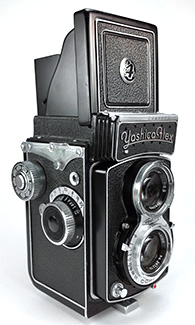
(2nd, 3rd, 6th and 7th images courtesy of Tom Heckhaus, 8th image courtesy of Chris Whelan)
The eight Yashicaflex model S images illustrate the continuous improvement approach of Yashima and represent the many changes that were gradually introduced in the period of its release in 1954 to 1957. The first version, not shown above but discussed further below, is similar to Camera 1 above but with the trim around the lensboard painted black. Camera 1 (fitted with later film wind knob) has the maker name on the nameplate with serial number on the underside of the nameplate flap over the exposure meter, different catch for the nameplate flap, NKS-FB shutter and Tri-Lausar lenses. Camera 2 has a revised nameplate flap catch, the serial number and “Made in Japan” on the nameplate front and Heliotar lenses. Camera 3 introduces a textured nameplate background without text. Camera 4 is one of the first with Copal shutter. Faceplate graphics are still the same style but there is “Yashica” between the lenses, the scales are reversed to suit the different shutters and of course, the shutter names are different. Camera 5 has new faceplate graphics. Camera 6 has the new body with long strap holders and 8 flag film speed reminder. Camera 7 has the new focusing knob, DoF scale and 9 flag film speed reminder and the flash sync has moved to the front. Camera 8 has mildly revised faceplate graphics with the “Yashica” oval between the lenses. It also has the moulded locking lever only found on cameras made after the first Yashica-Mats appeared in April 1957.
Note: All NKS-FB shutter examples have clearly earlier trim than any Copal shutter example, however, there is a cross-over of serial numbers from 30,000 to just over 34,000 shared by both types which is extremely confusing. It is one of the great Yashica mysteries, details are in The Conundrum of Serial Numbers further down. It is also the reason that I often identify shutter type with the serial number. For example, I don't know if an example with Copal shutter and serial number 31000 came off the production line before an example with NKS-FB shutter and serial number 33000 but I do know that the NKS-FB example will have the earlier trim still.
The Yashica Flex model S followed the Yashima Flex and perhaps Yashica Flex model B, although the evidence suggests that it was released near simultaneously with the latter camera and maybe even developed before it (see below). Note the same script on all three nameplates. Early in its life, Yashima changed the name in literature to the single word form, “Yashicaflex model S”, to match its new siblings in the Yashicaflex A series (see the manuals above). I tend to use the single word form when discussing the cameras collectively or those with Copal shutters but the two word form when referring to the introduction or those with NKS-FB shutters).
The Camera and Its Place in History
The Yashica Flex S is credited as being the first Japanese camera of any type and according to Japanese Wikipedia, the first 120 TLR in the world, to be fitted with a built-in (uncoupled) selenium cell exposure meter (the 1940 BB Semi First 120 folder made by Kuribayashi, later Petri, was fitted with an extinction meter and is credited as the first Japanese camera of any type with some form of built-in exposure meter). The model S is also amongst the first, if not the first, 120 TLRs anywhere fitted with any type exposure meter (the 1935 Zeiss Ikon Contaflex 35 mm TLR was the first of any type camera with built-in selenium cell meter and the 1953 Lumiflex Lumière 120 pseudo-TLR from France had an extinction meter built into the focusing hood). As such, it was truly a landmark model, setting Yashima apart from the gaggle of “me too” TLR makers, even if only briefly.
Note that the sometimes called “Yashicaflex S” with plain filter mounts is most likely to be the Yashicaflex AS-II economy model, based on the Yashicaflex A-II feature set with Yashimar lenses and Copal shutter with 1/200 top speed, no slow speeds and no self-timer (although the basic body and exposure meter is shared). The name on the meter flap is also different, matching the other A series cameras. Yashica documentation also describes a red window version called the AS-I but I have not come across any examples. The AS cameras do not precede model S – that has been a very common misconception. Both the model AS-II and model S lasted until after the introduction of the Yashica-Mat in April 1957 and had matching trim changes along the way.
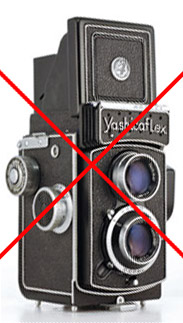 (Image courtesy of Tom Heckhaus)
(Image courtesy of Tom Heckhaus)
I ask, “why would anyone think that for their premier camera, Yashima would remove the self-timer and 1 second, 1/2 second and 1/5 second slow speeds of the first three models and 1/300 second top speed of the two previous models and use a lens only found on their economy series?”
Having said that, on the left is a framed ad and on the right, portions of another framed ad found for sale on a Japanese website. The accompanying text claims that they are from 1954 US magazines (detail on the back of the left one certainly could be from a US photographic magazine but no clue as to date or title - it could also, and possibly more likely, be from some English language publication aimed at overseas personnel stationed in Japan): Note the plain filter mounts!
(Right detail from larger web image)
(Click on left image for larger view of camera)
The drawing in the second ad is clearly depicting the camera in the first ad (all the features and trim match) and, spoiler alert, it is a form of Yashica Flex S. First, let's note that the style of nameplate lettering matches the Yashima Flex and Yashica Flex model B rather than the following A series cameras and that the exposure meter calculator scales on top of the cameras match the model S with a light value scale on the front edge, not the model AS-II which has the film speed scale there instead. Also, unlike the early model AS-II with a cable release shutter, this camera has a shutter button. More importantly, note that the specs are not for the model AS-II. With the Tri-Lausar lenses and NKS shutter with a full range of speeds and self-timer, the specs match the early model S, except for the 1/200 top speed in the first ad. The second ad adds a 1/300 speed to the specs whilst still showing a 1/200 speed as well - no NKS (or Copal) shutter fitted to Yashima's models has been found with both speeds but a little further down are details of an early exposure scale showing both speeds marked (a mistake in both design and marketing arising from a communication error somewhere?). A 1/300 top speed implies NKS-FB shutter but the drawing does not update the “NKS” text around the taking lens. The plain lens bezels and shutter details and graphics are completely Pigeonflex-like in appearance in both the photo and drawing and that would match the 1/200 top speed of the first ad. The maker name appearing on the nameplate is also in keeping with the Pigeonflex (it still appears on the first few model S examples found - see nameplates below). The photo seems to confirm the existence of this camera at a time when the Pigeonflex was still in production and the Yashima Flex had already received its new style nameplate and focusing hood, now seeming more likely considering the revised release date below. But did it ever make it into production or was this an early prototype that somehow turned up in marketing material? I'm strongly leaning towards the latter.
At the bottom of the specs in each ad is the separate name of “Baby SEKONIC Exposure Meter” and its picture and in the second ad, its specs. Also the Tokyo address of Seiko Electric Ind. Co., Ltd., the original maker name (no relationship to the Seiko of watches and Seikosha shutters). There is no reference anywhere to Yashima or “Model S” (the “Model B” was probably not released yet) and there is uncertainty as to whether the name is one word (first ad) or two words (second ad). They are clearly Seiko ads. No doubt the company was leveraging its involvement with the first Japanese camera with in-built selenium cell exposure meter (see more below) and who knows whether the images or ads were fully authorised by Yashima.
Confirmed Release Earlier then August 1954
In my mind, the release date has been quite controversial with all the quoted dates seeming far too late for the visual evidence. I can now say that it was unequivocally before August 1954 and probably several months earlier at least. I can say that with 100% confidence thanks to contributor Chris Whelan spotting this scan below:
 (Scan by rebollo_fr)
(Scan by rebollo_fr)
The scan is of the cover of Japanese magazine Photo Art (as translated), number 69 of August 1954 (details at Camera-wiki.org). The Yashica Flex S depicted has serial number 29901 which is the same camera that appears in Yashicaflex Photography. It already has a machined (silver) lensboard edge and later trim than my 29563 (featured further below) which is still not the earliest type and of course magazine lead times need to be added. Interestingly, the girl framed in the viewfinder is part of the larger group that appears on the reverse of the first two flyers below (the cameras on the front are the first type with black painted lens board trim). Chris Whelan tells me that her name is Yuko Yamaguchi.
Why does a few months matter? It matters to the relationship with the Yashica Flex model B and the subsequent A series cameras, particularly the AS-II, and the difference between this iconic camera appearing a little more than twelve months after the first model or almost two years later is very significant to evaluating the progress that Yashima was making.
The Release Date Saga
A number of sources claim that the camera was released in October 1954 at the same time as the Yashicaflex A-I and A-II. These are also the dates cited by author Karl F. Kahlau in the “Production List of Yashica 6x6 TLRs (based on original Yashica/Kyocera information)” in his book, “Collector's Pictoral Encyclopaedia & Value Guide to 6x6 TLR Cameras” (this book may be the source for some of the other claims).
A Yahoo search of Japanese sites for “Yashicaflex S” in Japanese has found “Document number: 103310371149” from the prestigious National Museum of Nature and Science, Tokyo. It contains a low resolution photo of a Yashicaflex S. The only interesting information is the release price of 20,000 yen and release date of December 1954. Is the date reliable? Almost certainly not. The research agency is quoted as “Japan Camera Foundation” and the location of the camera is “Nippon Foundation Camera Foundation Japan Camera Museum”. These are Google translations of what I think are the Japan Camera Inspection Institute (JCII) and its museum. I can't be absolutely certain but I am 98% sure that the camera is the same doubtful parts camera which appears in “The Evolution of the Japanese Camera” by Condax et al published by the International Museum of Photography, Rochester, NY. This was loaned from the JCII and appears further down in “Trim & Feature Changes - Overview” with an explanation regarding its “parts” status. I think that it is likely that Yashica provided the camera in 1969 (when the museum started its work) or later and that by this time, the poorly documented early corporate history was already a little hazy. Perhaps December was some other milestone, e.g., the release of the export focused version with Copal shutter would fit (that will become clearer in due course).
Two similar articles in separate Singaporean newspapers in November and December 1960 about Yashica and the two founding brothers, Yoshimasa and younger brother Jisaburo Ushiyama, quote a release date of April 1955 for the model S. The articles appear to be well researched and perhaps the background information came from Yashica itself. The 1955 year is clearly wrong based on any amount of evidence, but perhaps the month is correct and the date should be April 1954? It is possible that someone, somewhere made a mistake converting from the Japanese Showa period to the western calendar.
Previously, my assessment was that the release date was certainly a little earlier than October 1954 and perhaps a lot earlier in 1954. April would certainly fit. The first clue is the difference in the earlier naming schema and style compared to the Yashicaflex A series cameras discussed in Model Names and self-evident from the respective nameplates. The second clue is that the NSW State Library has in its archives a documented photo of a Yashica Flex S taken in out of the way Sydney (in Japanese TLR terms) in October 1954 (note also that that the agency that took the photo called it “Yashica Flex” i.e., the two word form):
 (The image is from the collections of the State Library of NSW and displayed in accordance with the Library's policies as at 24 Mar 2014)
(The image is from the collections of the State Library of NSW and displayed in accordance with the Library's policies as at 24 Mar 2014)
The digitised catalogue image is not the highest resolution but we can tell that the focusing lens board edge has a machined finish and the nameplate flap over the exposure meter has the serial number and “Made in Japan”. As discussed below, the earliest production version found has black painted trim with maker name instead of serial number on the nameplate flap and a different arrangement for the catch on the nameplate flap. Next came the machined aluminium trim with the maker name still on the nameplate flap and early catch. The third version is the same but with the new catch arrangement, then came the version with serial number and “Made in Japan” on the nameplate depicted in the Library's collection. So in October 1954, this was at least the fourth variation of the Yashica Flex S already.
In the Yashica Flex B section, I have argued why I believe the models B and S were released at, or near, the same time. The three flyers/brochures below are explained in the Yashica Flex B section and are part of the strong evidence that both models co-existed (the third brochure has the Yashica Flex model S on one side and Model B on the other):
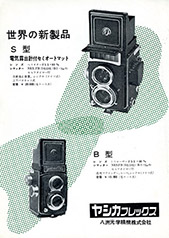
.jpg)
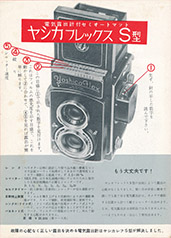 (Brochure scans 2 & 3 courtesy of Chris Whelan)
(Brochure scans 2 & 3 courtesy of Chris Whelan)
(Click on images for PDFs of complete brochures)
As an aside, the red text under the cameras of the middle document translates to something like “three years full warranty”. That seems very unusual and noteworthy for 1954, particularly for a fledgling camera maker in post-War Japan. However, the “Guaranty” document for the earlier Yashima Flex mentions “five years” (see Ownership page) and Canon offered 5 years with its rangefinder models of the time, perhaps setting the precedent.
Export Model
Several Japanese websites refer to the Yashica Flex S as an export model, Japanese Wikipedia says “export only” and at least one site calls it rare in Japan. I can only judge by what I find on various websites, particularly auction sites. Examples with NKS-FB shutters are not that common outside of Japan but do turn up, or at least used to, from time to time on eBay and were originally advertised in Sweden from the end of 1954 and there are also early English language brochures and ads. All found so far have focusing scales in metres. However, by far the majority in my database, including most of the early examples and all with the maker name on the nameplate, are from Japanese sites. There are also the three Japanese language brochures/flyers and a May 1955 ad which suggests that it was available in Japan. Sugiyama features an NKS-FB example and he seems to usually ignore export only models/versions. Therefore, it is probably not surprising that he doesn't mention the Copal shutter model which is heavily skewed towards feet focusing scales. I originally wrote about the Copal version, “I don't think I have found any on Japanese sites” but of course, the exception has then come along. It does have a focusing scale in feet so in that sense it is “the exception that proves the rule” and clearly was not intended for domestic consumption. So the claim on Japanese websites is probably correct that the model S was an export focused model, particularly the later Copal shutter version, but on the other hand, the early NKS-FB versions are certainly much more common in Japan than elsewhere. Definitely, not “export only”.
Introduction to Export Markets
The appearance of the Yashica Flex S in 1954 and 1955 Swedish advertising was covered in the Yashima Flex and Yashica Flex model B entries.
The relatively positive review in the March 1956 edition of Popular Photography seems to be introducing the brand to the magazine's readers for the first time, although there are plausible claims on a website forum of 1955 ads for both the models S and AS-II:
(Document image courtesy of Tom Heckhaus)
(Click on article for larger image)
Note that the camera photo is of the later body type with long strap holders but with side sync still. Unlike Yashima publicity shots, that would be consistent with the period. The review also wonders whether versions with focusing scales in feet rather than meters would become available. In fact, feet scales appeared shortly after the change to Copal shutters, say beginning of 1955, and both Leigh Harris' and my similar examples with short strap holders still (see fifth example above) already have the focusing scales in feet.
User Manuals (see at top of Yashica Flex S entry)
Early user manuals are rarely seen and Japanese language manuals seem even rarer. A single Japanese Yashica Flex model B manual has turned up but the Yashica Flex model S documents at the top are still among the first of any type that I have come across and certainly the first English language ones. Note that they may not be from the very beginning of model S production.
UK eBay seller Martin Gibbs has kindly provided a copy of the Yashica Flex S leaflet (see top at left). It came with camera 33xxx with NKS-FB shutter and lists the camera's features. By itself, it is quite unique and must be one of the earliest surviving examples of English language Yashima documentation. Today, we would simply call it a sales brochure but was there anything more in the box originally, such as an English language user manual?
The second sheet is what may have passed as the English language user manual for the NKS-FB shutter version, most probably from 1954, even though it came with the earliest Copal shutter example, 30210, (part of a relatively complete kit, see here). Which camera came first time-wise, the one with the lowest serial number or the earliest feature set? That question is dealt with further down without any real resolution. It may also be some sort of interim document, perhaps proper English language manuals weren't available yet. The content is halfway like the features list in the first leaflet and halfway like a very basic user manual. Unlike the other professionally printed items, the paper stock itself is heavy, absorbent mat finish of a type used by office copying technology of the time (that I remember from primary school in the 1950s). It certainly isn't a recent document. I found the camera on eBay but unusually for a Yashicaflex of this vintage, it was actually from my old home town in rural Australia which also has a sizeable military base. I also bought a slightly later version, serial number 559 higher, from another regional city with several nearby military bases. Australian troops were in Korea too and some remained for four years after the war. Many would have transited through Japan and spent leave time there. Somewhere in that might be a logical explanation. Or not.
Rather than being a one-off, a second identical one has turned up over 10 years later on the other side of the World tucked into the bottom of the ever-ready case for a model S, serial number 337xx, still with NKS-FB shutter and early features. I think that both examples predate the next document.
The Instruction Book third from the left, scans of which were kindly provided by eBay seller Kathryn, is the only dedicated model S user manual type I have seen. It is rare, the only other one I have come across was on a Chinese auction site belonging to a camera of similar vintage as this one. It is a foldout leaflet type which has come apart. New owner Chris Whelan advises that “Pages 2 and 3 are connected then the 2 outside pages (1 & 4) fold inward on top of 2 & 3. Then that puts pages 5 & 6 side by side.” The camera on the cover has serial number 30098 and is an early type with NKS-FB shutter, no leatherette insert on the meter cover but with Heliotar lenses already - certainly early but a little way into production. Inside is a later version (as well as 30098) with early body still but already with Copal shutter and the serial number inside the camera. It looks similar to the fourth camera at the top of the model S entry (with missing side leatherette). The manual is already from the time that the name changed from “Yashica Flex model S” to “Yashicaflex model S” with the single word form on the cover.
The user manual fourth from left, Yashicaflex Directions for Use, covered most Yashicaflex models in production at the time. It specifically refers to the operation of the Yashicaflex models A and C and covers the exposure meter of the models S and AS-II in a special supplement (often missing). Interestingly, the model S depicted in the supplement is the same 30098 as in the earlier Instruction Book. From the presence of the early Yashicaflex model C and the trim of the model A-II used to demonstrate many of the operations, I am guessing that it is from the second half of 1955. Tom Heckhaus has a copy annotated “Purchased Feb 1957 Okinawa”.
The last document contains selected pages from a Japanese language booklet. My first edition is from 10 August 1955, contributor Chris Whelan writes about his later 20 October 1955 reprint which includes a supplement for the Yashicaflex model C: “The user guide translates to the title 'Yashica flex Photography'. The booklet describes what a TLR is, briefly highlights the various Yashicaflex models (namely model S, A-II and C), tells how to take pictures and to set up a darkroom and develop your film and make prints. A small removable supplement, 6 fold out pages, describes the model C and how to use it.” More here. It is basically the Japanese equivalent of the Yashicaflex Directions for Use with a more general photography guide added. The Yashicaflex S used to illustrate exposure setting is 29901 - only 97 cameras before 30098 found in the English Language documents. The two cameras follow each other in my database. Considering Yashima's penchant for reusing images, why use two sets of images for the different language manuals? One reason could be that 29901 has Tri-Lausar lenses still and 30098 has Heliotar lenses already. This may have been seen as important from an export perspective, even if the trim of both cameras had been superceded for some time.
Boxes
Below left is the first style white box of my early bodied 30210 with Copal shutter already. On the right is one of two similar black boxes owned by Chris Whelan. The first belongs to slightly later example than mine with new body already and with which the above Instruction Book was found (the camera has an unusual serial number, 200142, which is featured further below):
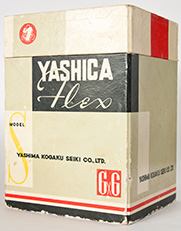
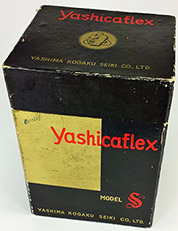
(Right image courtesy of Chris Whelan)
Boxes are covered on the Lens Caps, Cases & Boxes page but it is interesting to note that the left box matches the style of the Yashica Flex model B box and the other matches the style of the later Yashicaflex model AS-II box. They fit the release timeline that I have proposed better than the “conventional wisdom” timeline which I believe is based more on flawed logic than historical fact.
Exposure Meter
“S” in “model S” stands for “Sekonic”, the brand of Japanese selenium cell exposure meter grafted to the side of the bodies of both the Yashica Flex S and the Yashicaflex AS-I/AS-II pair. The maker name at the time was Seiko Electric Ind. Co., Ltd., (see above). It is not coupled to either shutter or aperture. The selenium cell on the camera is mounted behind a perforated flap which replaces the normal nameplate on other models.
In bright sunlight, the exposure meter is used with the flap down. The holes not only allow enough light through in bright conditions, the number and size were used by the factory to calibrate the meters (feature identified by Leigh Harris and explained to me by Simon A. Spaans).
 008.jpg)
 022.jpg)
 023.jpg)
Most of the cameras look like they have 12 holes but closer inspection shows that often they are not all opened, or fully opened, out. Some appear to have 11, or less. This late Yashicaflex S appears to have only 10 which on inspection reveals 8 fully open holes and two partially open holes. Dimples for the missing holes are still evident underneath.
The Sekonic model is the CB-1, very clear from the photos a little further below. The current Sekonic website lists three “Baby” models, the CB-1, the B-1 and B-2 and their “End of Life” (presumably as hand held meters); 1953 for the first two and 1954 for the B-2. These meters seem to have a reputation as well made, compact models. The rare translucent plastic model below is the only one with the scale along the top edge like on the Yashica Flex S so I presume that is the model CB-1. The underneath with the meter cell and the lift up flap appears to be similar on all.


(Detail from larger web images)
The meter scales with both “High” and “Low” ranges displayed are different to the light value scale of Yashica Flex S and different again to the Yashicaflex AS-II which uses an f/stop scale (as does the Yashica LM). The two cameras adjust for High and Low ranges by having the High range setting scale displayed on the top of the nameplate/ meter flap and as this is lifted, it drops from view as the Low range scale on the front edge of the flap (see below) replaces it. Very simple and elegant in operation, but a bit industrial design-wise and if the central scale slide is extended any distance, it becomes dangerously vulnerable:
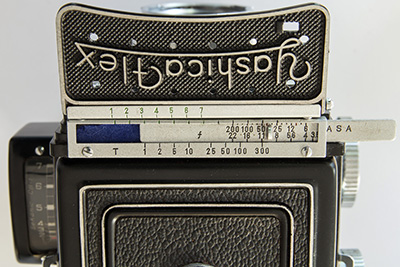
Note, I have shown the extension for effect. The exposure meter scale uses light values from 1 to 7 and the reading from the meter is transferred to the exposure calculator on top of the camera. The meter is currently reading a light value of about 2. To set a correct shutter speed and aperture combination, the slide should be moved to the left to line up the ASA speed of the film with the green “2” on the top light scale.
Exposure meter reading arrangements are covered in more detail in the comparison in the Yashicaflex AS-II section. Model S meters below:


Sixth earliest example (29563, still with Tri-Lausar lenses) in my database on left and towards the end of production on the right (71513). I'm not sure when the graphics changed but my two early bodied Copal versions are already basically the same as the late type.

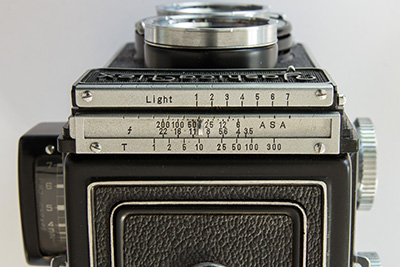
Still very early 29563 on the left, this time early bodied Copal version 30769 on the right (except for very minor font differences, for all intents and purposes, the top scales and the meter graphics are already identical to late camera 71513, note also that Copal shutter versions have later trim than NKS-FB type regardless of serial number). On the left camera, the “Light” value scale has been replaced (by me) with one from early NKS-FB camera 31954, which I hope is an exact match (font, “Light” centered front to back etc) and from photographs, seems to be. The difference left and right is significant. “F.Stop” has become “f”, “Time” has become “T” and “A.S.A. Speed” has become “ASA”. However the really interesting thing is that the earlier camera also has an intermediate “200”, or 1/200, shutter speed marked on the scale. Neither the NKS-FB or Copal shutters have an intermediate 1/200 speed between 1/100 and 1/300 so the obvious question is “why?” Noted further above is an early ad which may feature a prototype version with plain filter mounts. The specs list 1/100, 1/200 and 1/300 speeds. Maybe when the makers of the NKS shutter said, “we have added 1/300”, it was poorly phrased and they were misunderstood? The “200” speed disappeared from the “Time” scale just after the change from Tri-Lausar to Heliotar lenses, certainly by camera 313xx. The change to the later style of scales shown at right above also occurred very early on, around NKS-FB camera 314xx but there seems to be a transition period with both types found. Camera 31954 still has the earlier type ( without the “200”) as does camera 322xx. One of the first cameras with the new scales has the abbreviated “ASA” but instead of the stylised “f” for F Stop of later examples, it has a capital "F". This also appears on another nearby camera but it is not known whether it is an earlier or later type scale.
Two much later cameras with Copal shutters in my database, one with body serial number 70xxx and 247xxx and 246xxx lens numbers and the other with 246xxx lens numbers, have a focusing scale in meters and a European DIN scale on the exposure calculator on top of the camera in place of the usual ASA type. The film speed reminder on the film winder knob on one is definitely still a 9 flag ASA type and it also appears to be 9 flags on the other (not clear because of the angled view). These two are probably slightly earlier than the one Europe bound AS-II and several Yashica A, C and LM cameras found with 10 flag DIN type film speed reminders.
 (Detail from larger web image)
(Detail from larger web image)
Originally, the light value numbers on the front of the exposure scale were in black characters. It is very hard to tell from some photos but at sometime early in the NKS-FB shutter period but almost certainly by NKS-FB camera 329xx, front light scales changed to green. Camera 31954 is still definitely black, as are a number of following examples but there may be some slightly earlier cameras with the green text, the earliest possibility is 313xx. It didn't last long. The first camera with Copal shutter, 30210, has the green scales but by no more than 800 cameras later, the scales have changed back to black with several black ones also appearing a little earlier in the green period. This scale only comes into use in low light with the flap up and is offset with “6” and “7” overlapping the “1” and “2” of the top scale.



Light scale from NKS-FB camera 31954 (fitted to above camera 29563), early bodied Copal shutter version (30769) in the middle and late bodied version (71513).
Trim & Feature Changes - Overview
Below are the four variations of Yashica Flex S tripod mounts (the last type is also found with the moulded locking lever):
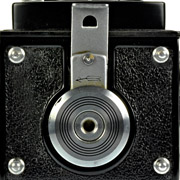
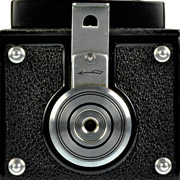
.jpg)
.jpg)
(Images 1 and 2 courtesy of Tom Heckhaus)
Four ring initially, change to three ring between NKS-FB cameras 305xx and 309xx and two black rings from introduction of the Copal shutter with camera 302xx. The change from four ring to three occurred at a similar time as for the Yashica Flex model B, see also Tripod Mounts/ Locking Knobs and the Yashica Flex B entry. The last type was introduced around camera 313xx shortly after the arrival of the new body.
When released, the Yashica Flex model S had an NKS-FB shutter fitted to the earlier short strap holder body before changing to a Copal shutter and then a little later, to the new body style with long strap holders. From the first, it was reputed to have Heliotar lenses but 24 of the first 28 with NKS-FB shutters in my database have pairs of Tri-Lausars, the last serial number being 3036x:

There were at least four styles of faceplate graphics:
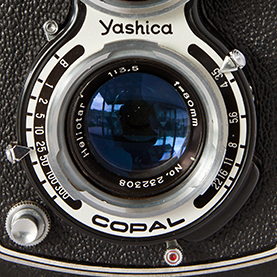
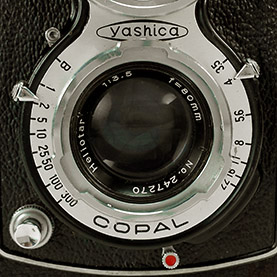
(Images 1 and 3 courtesy of Tom Heckhaus, image 4 is courtesy of Chris Whelan)
The styles depicted in Images 1 and 3 are the most commonly found. The first change came with the new Copal shutter (camera 3 at the top of the section) and with that the shutter faceplate aperture and shutter speed graphics were reversed to accommodate the different arrangements and the “Yashica” brand appeared between the lenses for the first time with “Copal” relegated to under the taking lens. The second change occurred very shortly afterwards. The final change occurred near the end (by the cameras' moulded locking levers, probably in 1957) when the “Yashica” between the lenses was changed to the oval surround type initially introduced on the Yashicaflex C in 1955 (in red, but the last few were black) and also found on 1956 Yashica C and LM and later models. The graphics on the faceplate were also made a little finer and match the last Yashicaflex C and also Yashica C and LM examples.
There were also at least four styles of nameplate flaps over the exposure meter. The first two types are similar and very rare with the maker name, “Yashima Kōgaku Seiki Co., Ltd.”, on the front as on the Pigeonflex and the serial number under the flap. They have a round “knob” insert on the side of the slot through which the tab on the exposure meter frame acts as a catch. The later types have a moulded in rectangular pad. The example on the left, serial number 29563, has a different style catch, explained further below. It appeared first even though the second camera, serial number 29425, has a slightly lower number. I would expect the black trimmed cameras below to have the lowest serial numbers but they are not visible.


(Right image courtesy of Sandu Baciu)
Below left is typical type associated with early Model S examples with NKS-FB shutters. It has the serial number and “Made in Japan” on the front. Below right is the typical textured type associated with later examples fitted with Copal shutters but this one belongs to the last NKS-FB example in my database.
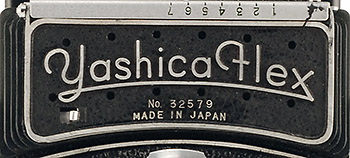
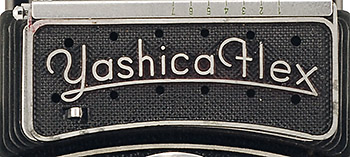
(Images courtesy of Tom Heckhaus)
Many early ads and brochures show the serial number on the flap. Those cameras also have silver trim (i.e. machined finish) on the edge of the focusing lens board panel already. Note that most of those ads and brochures are in English, or Swedish. When the Yashica Flex S was released, Yashima was not yet an established exporter and early cameras would have been destined for Japan. However, black focusing panel trim is not unexpected - it harks back to the earlier models and also features in the early leaflet at the top left of the Yashica Flex Model S section and the two versions of the flyer further above. Tom Heckhaus has sent me photos of somebody else's collection taken in 1999. Amongst some interesting examples was this Yashica Flex S, by its Tri-Lausar lens numbers, both in the 287xxx range, now the earliest Model S in my database (only the word “Tomioka”, which is not seen with Heliotars, is clear but there is also an annotation on the rear of one of the photos). Also like the next 37 examples, there is no leatherette insert on the exposure meter housing.


(Images courtesy of Tom Heckhaus)
Although the lensboard trim under the paint looks smoothly rounded and original, the black rimmed exposure meter flap is unlikely to be authentic. There is no precedent for a black rimmed nameplate in previous practice, photos or documentation, also, to me, it looks like smearing or brushing marks where the maker name or serial number would be. The catch on the meter flap is the later type and uses the moulded in pad already. Full resolution images of early documents featuring the black trimmed examples show the first type catch noted above. I would say the flap has been replaced (and the frame underneath) and maybe that explains the black paint on the flap (not sure why though)? In fact, it is probable that there has been a fault or damage and that the whole meter cell assembly has been replaced.
Another black trimmed example that raises more questions than it answers is the camera featured in the well known book “The Evolution of the Japanese Camera” by Condax et al published by the International Museum of Photography, Rochester, NY (several editions in the mid-1980s). The credit for loan of the camera is given to Japan Camera Inspection Institute (JCII). This prestigious Japanese peak photographic body was responsible for the “JCII” inspection tags in the 1950s and gold oval stickers from the 1960s to 1980s. From its own website, in 1969, JCII began to designate some cameras as “Historical Japanese Cameras” and “began efforts to preserve these important items”. It seems extremely likely that the featured model S was acquired some time after 1954 and possibly many years later:

(JCII example as featured in “The Evolution of the Japanese Camera” by Condax et al, further details above, image scan courtesy of Chris Whelan)
Even from the single photo, the issues with this nice looking camera are many. I personally visited the JCII Camera Museum in Tokyo in November 2016 and was lucky enough to see the camera on display. Unfortunately, photography inside the museum is not allowed but I did take notes and can confirm the serial numbers (partially visible in the photo) and some other details. In my excitement, I did stuff-up too, which I'll come to.
I think that it is obvious that the black trim is rare and only found on the earliest examples. However, the nameplate meter flap is already the later type featuring serial number with “Made in Japan” and later style retaining catch. The serial number is 33765 which is the fourth highest of the 45 NKS-FB examples currently in my database. The lenses are Heliotars rather than the Tri-Lausars of early examples. The taking lens serial number is 226126 and the viewing lens is 226153 which are a little low for the body number and would fit better with a camera with a serial number of about 315xx, i.e. still about halfway through the NKS-FB database. The flash sync socket on the side of the camera is the later PC type rather than the first ASA type of early examples (see below). The small knob on the end of the hinge pin of the exposure meter flap of this camera is the second type, obviously later than the first plain type (see below). The exposure scale on top of the camera does not include the 1/200 speed of earlier examples. The button release in the centre of the film winding knob is without the black dress ring, i.e. it is the type introduced with the change to Copal shutter (see below). Finally, the focusing knob end cap with slightly domed centre was first seen on the Yashicaflex C released in September 1955 and after that, only on model S examples with the later, “modern” focusing knobs.
Now to my failures; I didn't take note of whether the exposure meter assembly on the camera side has a leatherette insert or not. I am almost certain that it did have (in noting the PC flash sync, I obviously examined that side of the camera), again making it from a later period than the black trim suggests, but I cannot claim that 100%. Also, I didn't note whether the the light scale on the top edge at the front of the exposure meter flap was in black or green. I rather think it was black, correct for both first and later types, rather than green (brief period at the end of the NKS shutter type and start of Copal type).
Without a doubt, this is a parts camera. If JCII asked Yashica for an example, could Yashica have assembled this one out of spares years later? It seems unlikely that JCII would have simply wondered into a used camera store. The lesson from this camera is that don't always believe what you see.
This black trimmed example is from Japanese website moritz.co.jp and apart from perhaps leatherette repair, I believe it to be original:
 (Detail from larger image on moritz.co.jp website)
(Detail from larger image on moritz.co.jp website)
The body serial number is unknown and although the serial numbers on the Tomioka Tri-Lausars are very hard to make out, they look like 289071 for the taking lens and 287602 for the viewing lens. Although the taking lens serial number is slightly higher than the fourth example lens, the viewing lens is the lowest of all. I'm guessing that this could be the oldest, second oldest or third oldest example in my database but I have placed it second. I also believe that the nameplate flap with maker name and first type catch is what the first black trimmed example above should have.
The third camera in my database has well-worn black lensboard trim but clearly it is original, the edge having the typical rounded moulding, rather than the machined flat finish of later examples. It has the first type flap catch:
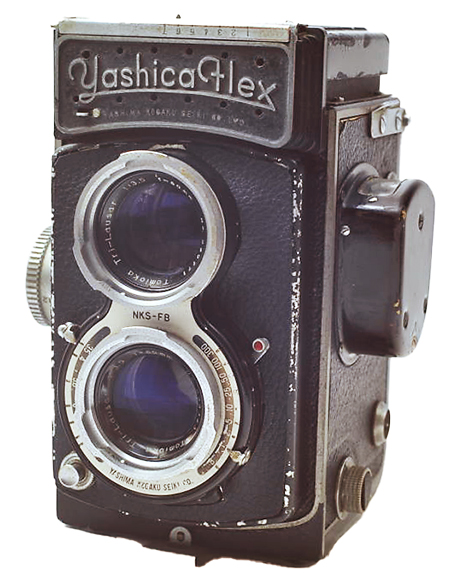 (Web image)
(Web image)
Again unfortunately, whilst the body serial number is visible under the flap in a couple of the auction photos, it is unreadable. The Tomioka Tr-Lausar taking lens number is not very clear either but looks like 289343. The viewing lens is clearly 289771.
The fourth example has a machined lensboard already and also the second type of flap catch. The body number is not visible but the lens numbers may be 288430 (taking) and 288463 which are slightly lower than the third example.
The fifth camera in my database also has the maker name on the nameplate with the serial number under the flap but has machined trim already and the later catch (but not moulded in pad yet):


(Images courtesy of Sandu Baciu)
Although the body serial number, 29425, is the lowest readable so far, unlike other cameras around it, it has Heliotar lenses already. Although the taking lens, 225951, is one of the lower Heliotars in the database, starting at 224400, the viewing lens, 276425, is significantly higher than any other Model S, or Hi-Mec, Heliotar which max out at 250097 - very confusing. Some other aspects of this camera suggest a mix of parts of different vintages and even models, e.g. the release button on the film wind knob looks like it belongs to a Copal shutter version (see below), the exposure meter flap release knob at the end of the hinge pin is from a little later in the NKS-FB period (starting with camera 310xx) and the camera back definitely has a straight type Yashicaflex A-II locking mechanism. On the other hand, the meter housing is the early type without leatherette insert, the focus knob DoF scale is the earlier, more horizontal type and undoubtedly, the meter flap is genuine with a very early number. The exposure scales on top are the first type including the 1/200 speed. A complete mystery.
The next example of this type, 29563, had both the focus knob plastic end cap and film winding knobs replaced by later items but I have re-fitted the correct type focus knob cap and replaced the missing “Light” scale attached to the nameplate exposure meter flap with one borrowed from camera 31954, which I hope is an exact match, but otherwise it seems original and it has the sixth lowest Tri-Lausar lens numbers, 291061 taking lens and 290216 viewing lens.


The nameplate exposure meter flap is still the first type with the round “knob” insert on the side of the slot through which the flat tab on the exposure meter frame acts as a catch. Later flaps have wider slots for a vertically orientated folded over hook formed from the meter frame pressing. This type has a simple single thickness horizontal tab with a shallow hook in the side. Although Sandu's camera (immediately above) is earlier than mine, the difference in serial numbers is only 138. As his camera has some later parts than mine including the Heliotar lenses, due to the vagaries of early production lines, his camera may have received the new flap first.
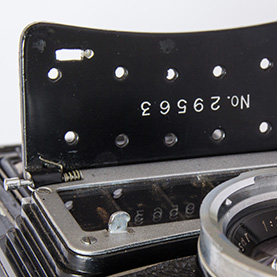
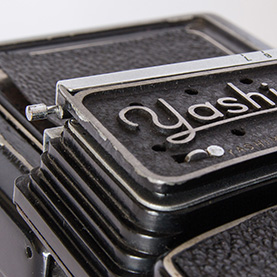
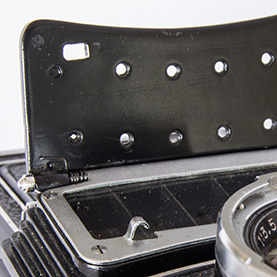
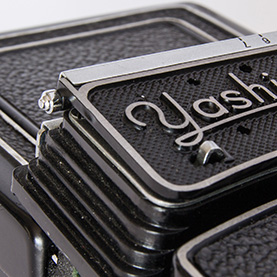
The other camera shown is a late version with Copal shutter and new body style. Note the different style knobs on the end of the hinge pin used for releasing the flap. This change occurred during the NKS-FB shutter period starting with camera 310xx.
Cameras subsequent to 29563 in my database have the serial number and “Made in Japan” on the outside of the flap and the later catch arrangement.
Between camera 301xx and 303xx (NKS-FB shutter version, early Copal shutter versions with lower serial numbers had later trim, see further below), the flash sync socket transitioned from ASA type with spring loaded centre pin to the German PC (Prontor-Compur) type. In the first leaflet/brochure at the top of this section, Yashima still refers to “Standard ASA connector”. The orange “The Special Features” sheet confirms that the sync of the NKS-FB shutter is set for short duration F type flash bulbs which normally require a 5 millisecond delay. I understand that the Copal shutters are X sync. ASA connector on left, PC type on right:
 010.jpg)
 016.jpg)
Starting around camera 310xx, the next change was that the fully enamelled meter housing on the camera side (left image above) received a leatherette insert to hide the three screws (right image). 34063 is the last example in my database with NKS-FB shutter and the first with a new nameplate style. Although it retained the original style and script, it was given a new textured finish like the earlier Yashima Flex and Yashica Flex B, “Made in Japan” was deleted and the serial number was relocated to inside the camera in the feed spool chamber.
Next, the camera was updated to the new Copal shutter and with that, the shutter faceplate was minimally revised (see further above). The serial number of the first is 30210 which is lower than the last of the NKS-FB shutter type. I am treating the numbers as separate ranges if no other reason than it is easier to understand - see further below. At the same time, the fixed aperture scale for depth of field behind the focusing knob became more vertical, or flatter to the camera body (see also Focusing Knobs):

.jpg) (Right image courtesy of Tom Heckhaus)
(Right image courtesy of Tom Heckhaus)
Note that the film winding knob and button on the early Yashica Flex Model S on the left are replacements from a later example.
Also, the three ring tripod mount changed to two ring type and the film winding knob release button lost the inner black dress ring (the knob detail on the left is from the last example with NKS-FB shutter and the right detail belongs to an early example with Copal shutter but is the same as the first one with the Copal):
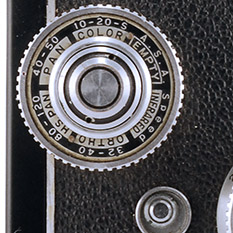
 (Left image courtesy of Tom Heckhaus)
(Left image courtesy of Tom Heckhaus)
Then the aperture and shutter speed graphics on the faceplate changed to the later and more familiar style. Two Copal shutter cameras from this period, 30769 and the following example in my database, 308xx, have a different pin alignment for their internal Bay 1 accessory mounts. An earlier example, representative of most Yashica and other maker Bay 1 mounts is shown on the left with the top spring pin on the left of the top bayonet receptacle and camera 30769 is on the right with the pin on the right. The different locations of the bottom spring pins and single stop pin are also evident (more details are at Bay 1 Mounts):


Not long afterwards, between serial numbers 30900 and 31000, the Yashicaflex S was updated to the new style, long strap holder type body. Within a few hundred cameras, it received the new 8 flag ASA reminder on the film winding knob. This is probably when the locking lever changed from the first Pigeonflex style tripod mount to the new locking knob (see further above and also Locking Levers and Tripod Mounts/ Locking Knobs).
Shortly after (between 3151x and 3154x), the three screws disappeared from the spool knob backing plates. Shortly after camera 3184x came a new numbering system with the first camera in my database being 6611x. The new type focusing knob and depth of field scale that appear on all later knob wind models followed at camera 6722x whilst at the same time, the flash sync moved from the side to the front. Immediately after this, the ASA reminder changed to 9 flags and it wasn't long before the spool knobs changed from full width knurling to an edge ridge (6997x).
Starting a transition at around 716xx, the very last type Yashicaflex S received the new type moulded locking lever instead of bent strap and the “Yashica” between the lenses was changed to the oval surround type. The new locking lever first appeared on the Yashicaflex AS released in May 1957 with the first Yashica-Mats still featuring the earlier type. This is consistent with a Yashicaflex S still appearing in a 1957 Swedish ad (called “Yashica S” in the ad).

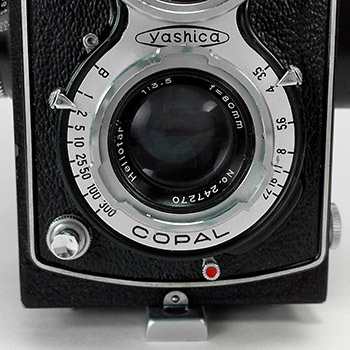
(Images courtesy of Chris Whelan)
Here are some additional views of five of the many variations of the Yashica Flex S. Thumbnails are linked to larger versions:
NKS-FB shutter:
Images 1 & 2 early nameplate and Tri-Lausars, images 3 & 4 later nameplate and Heliotars
Copal shutter, early body:
Images 1 & 2 early faceplate, images 3 to 8 later faceplate
Copal shutter, new body, new focusing knob, front sync:
(Click on camera to view larger image)
Trim & Feature Changes - By Serial Number
The Conundrum of Serial Numbers: Now there is something very strange with Yashicaflex S serial numbers. Currently there are 206 in my database, 96 with NKS-FB shutters and 110 with Copal shutters. The serial numbers of the NKS-FB examples range from 29425 to 34063 with Tri-Lausar lenses from 28771x to 297662 and Heliotar lenses from 224254 to 231988 (not including the out of range viewing lens, 276425, mentioned earlier). The first Copal shutter example has the serial number 30210, some 3,800 less than the last NKS-FB example. It is tempting to put his down to a very long transition period but the Copal cameras have all the trim updates of the NKS-FB examples including the new textured nameplate meter flap introduced with the last of them, e.g. at around serial number 310xx, NKS-FB examples were given a leatherette insert in the side of the exposure meter body whereas this a feature of all Copal shutter examples from the beginning. Also, whereas the body numbers have regressed, the Heliotar lens numbers continue on from 232167 to the end, 250097, as if nothing had changed. As noted earlier, at about serial number 30900, Copal shutter cameras transitioned to the new body with long strap holders. The serial numbers rise to 31847 before a new numbering range beginning with “61” is introduced, still some 2,216 below the last of the NKS-FB examples.
The table of found early Yashica Flex S examples below illustrates the conundrum:
(Click on table for full screen view)
Note that the body serial numbers of Copal shutter models are inside in the feed chamber and therefore many are not visible in photos. Affected examples have been placed according to lens numbers and trim. Note also that I have included the first of the “6” series numbers for illustrative purposes only - with those I have not included examples where the body number is unknown.
Whilst there is a little transitional overlap between the first two groups, the second clearly follows the first. The “3” series Copal shutter numbers look like a subset of the NKS-FB series, yet in trim, they clearly follow that group.
Two Models?: The only way to make sense of trim changes in my database is to separate the Yashicaflex S entries into NKS-FB and Copal shutter versions as if they were separate but coexisting models (even though I don't believe that they are). As I have found most of the NKS-FB cameras from Japanese sites, it is possible that these may have continued in production for the domestic market for a while longer after the Copal models were introduced, perhaps as an export only version. Perhaps there was a supply of parts to be used up or deliveries of the NKS shutters was delayed and parts, including lenses, had already been set aside for them. At this stage, it remains a mystery.
The Copal Series: The initial changes that occurred with the introduction of the Copal shutter were minor. The first nine are different to the later NKS-FB cameras in that the otherwise similar appearing shutter and faceplate have the aperture and speed graphics reversed to match the different shutters and also “Yashica” appears for the first time between the lenses and the shutter name “Copal” is relegated to under the viewing lens. Also the release button for the film winding knob has had a minor update as noted above and the DoF scale behind the focusing knob is more vertical. The tripod mount now has only two rings. The nameplate flap over the selenium cell had already changed with the last of the NKS-FB cameras. At around serial number 305xx, the faceplate graphics changed again. Also at about this time, the first cameras with feet scaled focusing knobs appear. My 30769 has both the new graphics and feet scale but also still has the Pigeonflex type locking mechanism (with bent strap lever). At around 309xx, the body changed to the new, long strap holder type and between 310xx and 314xx the camera received the 8 flag ASA reminder in lieu of the original hybrid 6 flag reminder and also a new back with the later style locking knob mechanism. At 315xx, the spool knob backing plates lost the three exposed screws.
Somewhere in this period are two unusual cameras with 6 digit serial numbers. The first, 2000xx with taking lens 234xxx and viewing lens 233xxx and the second, image immediately below, with body number 200142 and both lenses in the 234xxx range. The first is possibly the last example (in my database - some surrounding cameras only have lens numbers visible) of the old body with short strap holders and the second is possibly the first example with the new body and long strap holders. The following new bodied cameras carry on with the earlier 30xxx-31xxx numbering range.
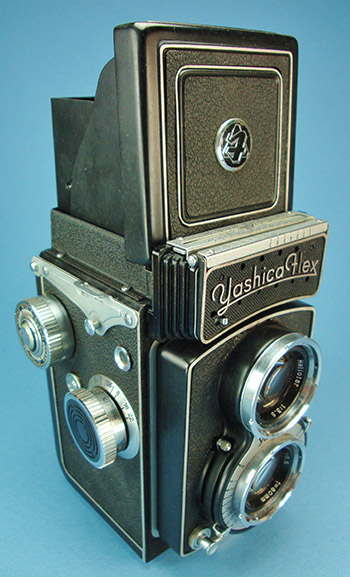

(Images courtesy of Chris Whelan)
The earlier camera exhibits some fiddling - it has a later film reminder on its film wind knob and its faceplate has “Made in Japan” which only first appeared on any faceplate in late 1958. The various graphic design elements of the faceplate itself are clearly from a later period but don't match any other camera that I am aware of. Yet it appears to be made for Yashicaflex S and C models, the only two cameras with Bay 1 lens mounts and plain Copal 1-1/300 shutters (as opposed to Copal MX on the following LM and C). I can only think that it is a later made Yashica spare part to suit both the Yashicaflex S and C - there were an enormous number of Cs sold in Japan. There is no damage to the matching front leatherette so a factory/service centre repair is highly likely.
Compare this to the very late model S faceplate in photos further above - no “Made in Japan” and the aperture scale is black. Early model C examples are coarser featured than this one, have no “Made in Japan” and the “Yashica” in the oval is red. Later ones look more like this but the aperture scales are now also black and there is still no “Made in Japan”. I think that it is a significant example but I am not entirely sure of what yet.
 (Detail from larger web image)
(Detail from larger web image)
The second camera is entirely consistent with cameras that it shares trim features and lens serial number ranges with. It is in nice condition and came with the second of the Yashicaflex S box types, ever-ready case, user manual and guarantee certificate (not completed) featured elsewhere on this site as well as the correct lens cap (there is an anomaly in that the case has no provision for side flash sync socket whilst the camera is still side sync).
The 6 digit body numbers match no other model S serial numbers (all 5 digit), nor Yashicaflex AS-II, Yashica LM or Yashica Hi-Mec internal serial numbers. A complete mystery.
The next body serial numbers in my database are still in the 31xxx range (remember that the 34xxx of the last of the early cameras with NKS-FB shutter still has the early trim features) with lens numbers rising to 236xxx. Then there is a big jump to camera 66xxx, a difference of about 34 or 35,000. There is no gap in lens serial numbers, these progress normally. At 67xxx, the flash sync moved from the side to the front upper right and a few cameras later, the film winding knobs changed from the 8 flag type to 9 flags. Between 69xxx and 70xxx, the spool knobs changed to the later type. Camera 714xx (high lens numbers both in the 249xxx range) is the first with moulded locking lever instead of the bent strap type and with “Yashica” in an oval logo between the lenses. At the same time, the face plate graphics became finer still, more like later cameras. My 71513 with taking lens 247094 and viewing lens 247338 reverts to the earlier generation with its bent strap locking lever and earlier name and graphics style as do the next six cameras with numbers from 715xx to 716 and lenses in the 247xxx to 248xxx range. Nine of the last ten cameras, with lenses ranging from 247xxx to 250xxx including the last seven cameras with body numbers 716xx to the last one, 721xx, including Chris Whelan's third last 71911 featured further above, have all the expected new features but one, 717xx, doesn't.
The change in spool knobs places the last cameras in the same time period as early to mid Yashica LM production – late 1956 to early 1957, an export focused camera that logically seems to be its replacement. The change to moulded locking lever probably didn't come until after the introduction of the Yashica-Mat in April 1957. Twenty one of the last twenty three cameras in the database have focus scales in feet (the other two are unknown) so it would be easy to assume that export must have been the focus. It is possible that a small number went to the UK, although Japanese imports were severely restricted in the 1950s. Whilst there is evidence of US activity in 1956, and anecdotal evidence of 1955 ads (plus the unusual 1954 ad at the top of the entry), I have personally not seen any US ads, or mention in brochures, for the Yashicaflex S in the 1956 to 1957 period even though the Yashica LM featured quite often. It is possible that those cameras were mainly destined for US military personnel still in, or transiting Japan.
.jpg)
.jpg)
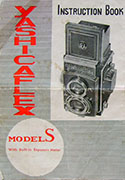
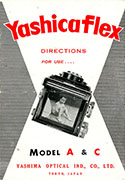
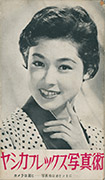


.jpg)
 038.jpg)
 040.jpg)
 003.jpg)
 001.jpg)
01.jpg)
02.jpg)
03.jpg)
04.jpg)
05.jpg)
06.jpg)
07.jpg)
08.jpg)
09.jpg)
10.jpg)
11.jpg)
12.jpg)
.jpg)